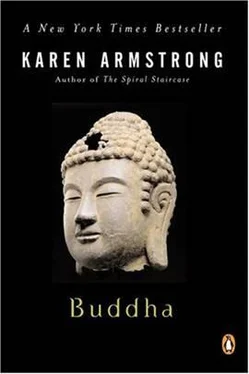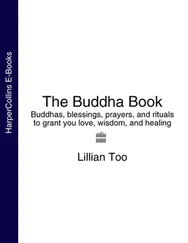Thus the Ajivakas, who followed the teachers Makkali Gosala and Purana Kassapa, denied the current theory of kamma: they believed that everybody would eventually enjoy liberation from samsara, even though this process could take thousands of years. Each person had to pass through a fixed number of lives and experience every form of life. The point of this dhamma was to cultivate peace of mind; there was no point in worrying about the future, since everything was predestined. In a similar spirit, the Materialists, led by the sage Ajita, denied the doctrine of reincarnation, arguing that since human beings were wholly physical creatures, they would simply return to the elements after death. The way you behaved was a matter of no importance, therefore, since everybody had the same fate; but it was probably better to foster goodwill and happiness by doing as one pleased and performing only those kamma which furthered those ends. Sanjaya, the leader of the Skeptics, rejected the possibility of any final truth and taught that all kamma should aim at cultivating friendship and peace of mind. Since all truth was relative, discussion could lead only to acrimony and should be avoided. The Jains, led in Gotama’s lifetime by Vardhamana Jnatiputra, known as Mahavira (the Great Hero), believed that bad kamma covered the soul with a fine dust, which weighed it down. Some, therefore, tried to avoid any activity whatsoever, especially those kamma which might injure another creature-even a plant or an insect. Some Jains tried to remain immobile, lest they inadvertently tread on a stick or spill a drop of water, since these lower forms of life all contained living souls, trapped by bad kamma performed in previous lives. But Jains often combined this extraordinary gentleness with a violence toward themselves, doing horrific penance in an attempt to burn away the effects of bad kamma: they would starve themselves, refuse to drink or to wash and expose themselves to the extremes of heat and cold.
Gotama did not join any of these sanghas. Instead he went to the neighborhood of Vesall, the capital of the Videha republic, to be initiated in the dhamma of Alara Kalama, who seems to have taught a form of Samkhya. Gotama may have already been familiar with this school, since the philosophy of Samkhya (discrimination) had first been taught by the seventh-century teacher Kapila, who had links with Kapila-vatthu. This school believed that ignorance, rather than desire, lay at the root of our problems; our suffering derived from our lack of understanding of the true Self. We confused this Self with our ordinary psychomental life, but to gain liberation we had to become aware at a profound level that the Self had nothing to do with these transient, limited and unsatisfactory states of mind. The Self was eternal and identical with the Absolute Spirit ( purusa ) that is dormant in every thing and every body but concealed by the material world of nature ( praktri ) . The goal of the holy life, according to Samkhya, was to learn to discriminate purusa from praktri. The aspirant had to learn to live above the confusion of the emotions and cultivate the intellect, the purest part of the human being, which had the power to reflect the eternal Spirit, in the same way that a flower is reflected in a mirror. This was not an easy process, but as soon as a monk became truly aware that his true Self was entirely free, absolute and eternal, he achieved liberation. Nature ( praktri ) would then immediately withdraw from the Self, “like a dancer who departs after having satisfied her master’s desire,” as one of the classic texts puts it. Once this had happened, the monk would achieve enlightenment, because he had woken up to his true nature. Suffering could no longer touch him, because he knew that he was eternal and absolute. Indeed, he would find himself saying “it suffers” rather than “I suffer,” because pain had become a remote experience, distant from what he now understood to be his truest identity. The enlightened sage would continue to live in the world and would burn up the remains of the bad kamma he had committed, but when he died he would never be reborn, because he had achieved emancipation from material praktri.
Gotama found Samkhya congenial and, when he came to formulate his own dhamma, he retained some elements of this philosophy. It was clearly an attractive ideology to somebody like Gotama, who had so recently experienced the disenchantment of the world, because it taught the aspirant to look for holiness everywhere. Nature ( praktri ) was simply an ephemeral phenomenon, and however disturbing it appeared, it was not the final reality. To those who felt that the world had become an alien place, however, Samkhya was a healing vision, because it taught that, despite its unpromising exterior, nature was our friend. It could help human beings to achieve enlightenment. Like men and women, every single creature in the natural world was also driven by the need to liberate the Self; Nature was thus bent on superseding itself and allowing the Self to go free. Even suffering had a redemptive role, because the more we suffered, the more we longed for an existence that would be free of such pain; the more we experienced the constraints of the world of praktri, the more we yearned for release. The more fully we realized that our lives were conditioned by outside forces, the more we desired the absolute, unconditioned reality of purusa. But however strong his desire, an ascetic often found that it was extremely difficult to liberate himself from the material world. How could mortal human beings, plagued by the turbulent life of the emotions and the anarchic life of the body, rise above this disturbance and live by the intellect alone?
Gotama soon came up against this problem and found that contemplating the truths of Samkhya brought no real relief, but at first he made great strides. Alara Kalama accepted him as a pupil and promised him that in a very short time he would understand the dhamma and know as much as his teacher. He would make the doctrine his own. Gotama quickly mastered the essentials, and was soon able to recite the teachings of his master as proficiently as could the other members of the sangha, but he was not convinced. Something was missing. Alara Kalama had assured him that he would “realize” these teachings and achieve a “direct knowledge” of them. They would not remain truths that existed apart from himself, but would be so integrated with his own psyche that they would become a reality in his life. Soon he would become a living embodiment of the dhamma. But this was not happening. He was not “entering into” the doctrine and “dwelling in it,” as Alara Kalama had predicted; the teachings remained remote, metaphysical abstractions and seemed to have little to do with him personally. Try as he would, he could gain no glimmer of his real Self, which remained obstinately hidden by what seemed an impenetrable rind of praktri. This is a common religious predicament. People often take the truths of a tradition on faith, accepting the testimony of other people, but find that the inner kernel of the religion, its luminous essence, remains elusive. But Gotama had little time for this approach. He always refused to take anything on trust, and later, when he had his own sangha, he insistently warned his disciples not to take anything at all on hearsay. They must not swallow everything that their teacher told them uncritically, but test the dhamma at every point, making sure that it resonated with their own experience.
So even at this very early stage in his quest, he refused to accept Alara Kalama’s dhamma as a matter of faith. He went to his master and asked him how he had managed to “realize” these doctrines: Surely he had not simply taken somebody else’s word for all this? Alara Kalama admitted that he had not achieved his “direct knowledge” of Samkhya by contemplation alone. He had not penetrated these doctrines simply by normal, rational thought, but by using the disciplines of yoga.
Читать дальше












